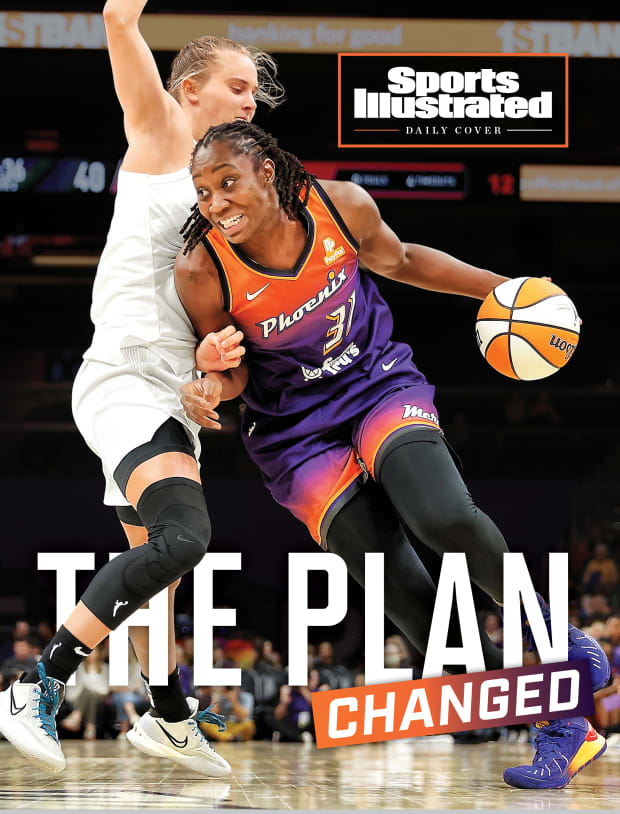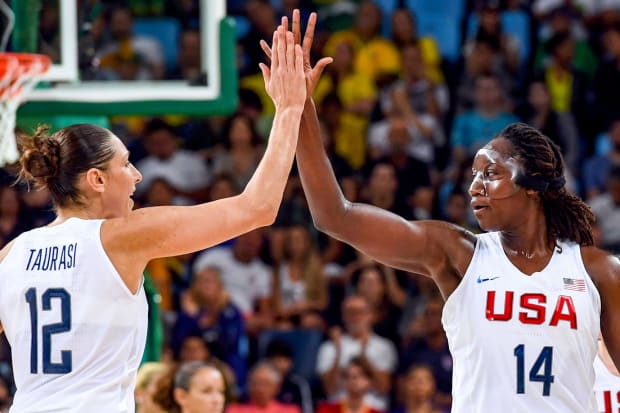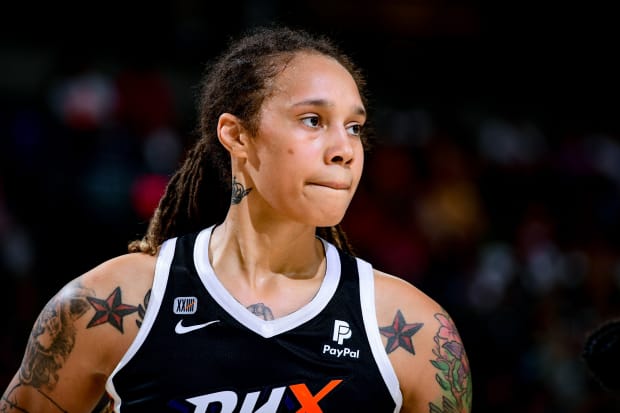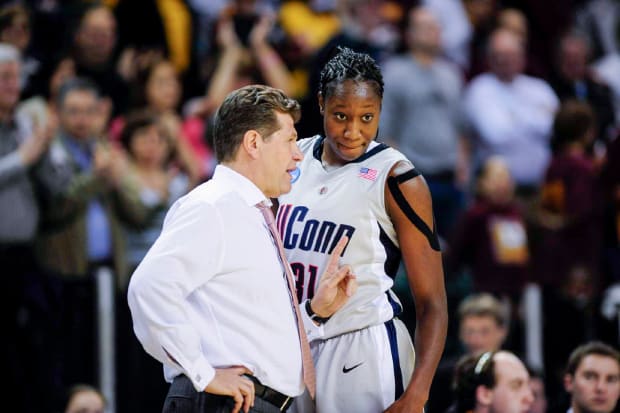Before a mid-May practice at the Mercury’s facility in Scottsdale, Ariz., Tina Charles worked through her offensive repertoire. Or, rather, she worked through what portion of it she could, in the space of a half hour. Charles possesses her sport’s thickest catalog of low-post maneuvers: pivots and reverse-pivots, shoulder-shimmy misdirects, up-and-unders and step-throughs and one-footed fadeaways, lately buttressed by a quickening handle and smooth three-point stroke. While Diana Taurasi and Skylar Diggins-Smith, two tentpoles of the Mercury team that made last year’s WNBA Finals, played a shooting game on the far court, Charles sweated on the near one, sidestepping into threes and spinning jump hooks from her fingertips. Snaps of wrist and snaps of net, again and again.
The idea, when Charles signed in February, was that her bucket-getting acumen would give last season’s runner-up a champion’s finish, and that the Mercury roster would give the 12th-year center, who led the league in scoring last season, the only line item her Hall of Fame résumé lacks. Vanessa Nygaard, Phoenix’s first-year coach, speaks of Charles as the rare frontcourt player—maybe the only one leaguewide—who could slot in comfortably alongside all the Mercury’s incumbent All-Stars, doing dirty work on the block on some possessions, dragging double teams away from Brittney Griner on others. With Griner’s wrongful detainment in Russia, though, the newcomer went from complement to stopgap. “She’s the most versatile back-to-the-basket post player we have in the game,” Nygaard says. “Seeing her play opposite BG obviously hasn’t happened so far,” she adds grimly, “but what a tremendous asset, to have Tina Charles to plug in when your center is in a Russian jail.”
Taurasi is terse on the subject, as on most things related to Griner’s detention. “That was the plan,” Taurasi says of the Charles-Griner combo. “The plan changed.”

Christian Petersen/Getty Images
Charles is tall, but not overwhelmingly so: 6'4", with long arms that extend her reach a couple of inches beyond what the listed height would suggest. She has muscular shoulders and wide hands and even midgame moderates her competitors’ locked-in look with one of curiosity. (A caricaturist would pick out Taurasi’s lasered-in glare and Diggins-Smith’s exhorting gestures; they might home in on Charles’s raised eyebrows.) At 33 years old, she has built a career as consistent and distinguished as any in her generation, winning an MVP award and two scoring titles, earning eight All-Star berths in 11 seasons, recently moving into fifth place on the all-time scoring list. But she’s done so without much help, for clubs that haven’t gone far, and what looked in the winter like a respite has turned into another tough challenge in a basketball life defined by them.
Charles insists that her story—up to and including this unforeseeable season in Phoenix—isn’t one of what could have been. The protracted championship chase, in her telling, is what has built her remarkable steadiness, her appetite for annual improvement. The scoring totals have added up because she’s chipped away at whatever weakness she could find, losses sharpening obsession. She attends to her game the way a pit crew examines its car, bolt by bolt and valve by valve. Perfection is impossible, she grants. But somewhere between where she is now and that impossibility might someday lie a title.
“You don’t get to choose the time; the time chooses you,” Charles says without bitterness. She invokes a family credo that has hardened over the years into a mantra, for when good things look far off. “Delayed is not denied.”
When Charles came to Phoenix, it seemed the ideal marriage: the later-career icon and the club that had fallen two wins short of a title the year before. The only problems would be those tailored to the superteam: Who would sacrifice scoring numbers, among Taurasi and Diggins-Smith and Charles and Griner? How would they learn to react to one another’s actions, instead of initiating? “That’s gonna be the challenge, when you put together a lot of talented players,” Taurasi said in May, daydreaming of another timeline in which shot distribution was the pressing issue. “Everyone’s used to being the most talented player on the team.”
Without Griner the Mercury struggled to a 2–8 record to start the season but have played .500 ball since. (A reminder of how quickly fortunes can change in the W: Last year’s team started 5–7 before finishing 19–13 and mounting their charge to the Finals.) Charles’s numbers show the process of acclimation. In a 27-point loss to the Dream in late May, Charles missed nine of 11 shots and grabbed just a pair of rebounds, but two weeks later she put up 20 and nine as the Mercury eked out a two-point win. She made two of four three-pointers and stepped smoothly into open space on pick-and-rolls. She shouldered her defender back and leaned into a one-legged fadeaway. On one fourth-quarter possession, she curled around a screen for a triple, beating the shot clock, and on the next she faked the shot and glided to the rim for a finger-roll—the new stuff setting up the old.
“I’m just gonna keep being present,” Charles said at the start of the season, of trying to master one role while preparing for the possibility of another. “I can’t think that far.” She talks, in the way experienced athletes tend to, about what she can control: fine-tuning the partnership with Taurasi, dialing in the ratio of back-to-the-basket burliness to three-point marksmanship. Still, like everyone on the Mercury’s roster, she lets her mind drift into the occasional oasis of what-if. “God willing, I hope that BG can come back, and then I can approach the situation as I always planned to.”

Mark Ralston/AFP/Getty Images
If Charles’s basketball life has been defined by her remarkable talent, it has also been characterized by that talent undergoing arduous testing. Charles came to UConn in 2006 after a prep career that was decorated in the extreme. At Christ the King High School in Queens, she had been the best player on the nation’s best team, at one point ripping off 57 consecutive wins. (Charles’s mother, Angella Holgate, immigrated to New York from Jamaica, and Charles first practiced post moves on a Fisher Price hoop draped in the jersey of fellow Jamaican Patrick Ewing; the prep circuit at times presented not much more challenge than that.)
But over her first two seasons in Storrs, Charles looked at times less like the top-ranked center tabbed to extend the program’s dominance and at others like an unsteady underclassman, executing a deft reverse layup on one possession and flubbing a routine finish the next. She drew Geno Auriemma’s ire for bouts of inattention during games, and in practices she often got banished to a side court to drill fundamentals while the rest of the team ran sets. Some weekends, Charles would drive back to New York and sit with her mother in her childhood bedroom, decorated with a Lisa Leslie magazine cover and Kevin Garnett poster, shedding tears.
“It was a tough first couple years,” Holgate says. “The way she felt—I just didn’t want her to feel that way. There were times I thought UConn wasn’t the place for her. But then I’d think, if she wants to be the best, this is the program that’s going to make her the best. She’d come home and I’d tell her, ‘You have to go back.’”
The end of Charles’s sophomore season, in 2008, came when UConn lost to Stanford in the national semifinal. Charles managed just nine points and six rebounds; the Cardinal’s starting frontcourt combined for 32 and 17. When the Huskies returned to Connecticut, Auriemma gathered the team in Gampel Pavilion for a state-of-the-program address.
“In order to win a championship, you have to have a really great point guard, which we have in Renee Montgomery. You have to have a really great three-guard, which we have in Maya Moore. But we’re missing that four and five. We don’t have that,” Charles recalls Auriemma saying, standing in front of his entire roster. “Tina Charles, I believe you can be that, but you’re going to take us as far as you go. If this is how you want to be—can’t rise to the occasion, can’t be tough, let [Stanford center] Jayne Appel kick your ass—we’re not gonna go anywhere. We’re always going to have this feeling. But if you can turn that corner, I believe that we can be better.”
So began a lifetime of corner-turning. That offseason, Charles submitted herself to a breaking down and rebuilding at the hands of Chris Dailey, a UConn assistant. It began with what would become bedrock: the hook shot. Dailey realigned Charles’s sneakers and grabbed and twisted her elbows—the puppeteer to a future Hall of Fame marionette. Dailey hoisted a broom as a stand-in defender, demanding the proper arc and smacking shots away when they failed to reach it. “It was all mechanics: how to hold the ball in your hand, how to use your off-arm to block the defender,” Charles says. “I just started always being in the gym. If I had class at 8, I’m in the gym at 7. And I can say that’s when those hook shots started to fall in.”
The next season, Charles met Auriemma’s demands. Her averages ticked upward—16.5 points and 8.9 rebounds per game—as the Huskies became the first team in Division 1 history to go undefeated with double-digit margins of victory in each game. (They wouldn’t lose a game the following year, either.) If Moore, with her shutter-quick first step and gleaming jump shot, supplied UConn’s glitz, Charles had become its backbone. In the 2009 national championship against Louisville, she notched 25 points and 19 rebounds in a game that seemed less like a competition than a recital. The moves she once agonized over in workouts came in tempo on a Final Four–branded floor in St. Louis. She could take a long step into the lane and get the ball on the rim before her defender had time to jump; she could spin back around and bank a fadeaway off the glass. Charles went from bearing the blame for a season’s ending to winning the Most Outstanding Player award.
That night, past the confetti and photo ops and net-cutting, Charles found her mother at the players’ reception in the team hotel. Holgate embraced her daughter and instructed her to hold her college years as a blueprint, to internalize the relationship between shortcoming and success. “Job well done,” Holgate said. “This is just one. There are more to come.”

Michael Gonzales/NBAE/Getty Images
More than a decade later, Charles walked into another gym. Ten professional seasons with the Sun and Liberty had seen Charles log historic personal accomplishments—18 points and nine and a half rebounds per game, the statistics a year-by-year metronome and the hook shot a game-by-game one—but do little real winning, her playoff experience topping out at a pair of conference-finals losses. After the 2019 season, she wanted to try her luck elsewhere and explored trade options. (Since she was a “core” player, Charles and the Liberty would have to agree on any deal, per league rules.) Taurasi, who fostered a relationship with Charles when she matriculated at UConn and went on to play with her in Turkey and on the U.S. Olympic squad, had then hectored her to come to Arizona. (Taurasi has a special regard for a little-known Charles masterpiece from overseas, when she scored 50 points to drag their team to a win in an otherwise meaningless contest. “We were in first by like five games,” Taurasi says, laughing, “but she did anything it took.”) Charles instead opted for Washington, where she could stay closer to home and play alongside another wing superstar in Elena Delle Donne, but not without doubt. Charles remembers telling Taurasi that she’d have to pass on the offer. “I felt like I just hung up on Kobe Bryant.”
After the onset of the coronavirus pandemic, Charles sat out 2020’s bubble season, decamping instead to a high school court in Williamsburg, Brooklyn, with her trainer, Tim Burns. The floor was rife with dead spots, and the rims creaked—the perfect setting, in other words, for another montage of secluded self-improvement. “I felt like I was being slept on,” Charles says. “In our league, it’s about championships, and at the time, playing in New York, we were dead last from 2018 to 2020, so my name wasn’t as relevant. But I felt that I had more skill than the players I was competing against; I was getting double- and triple-teamed. At the same time, we’ve seen what Jonquel Jones, Breanna Stewart, Elena Delle Donne can do, stepping out to the perimeter.” Charles borrowed her college coach’s language. “I called Coach T and said, ‘There’s another corner that I can turn.’”
The preeminent post player of her generation set about attaching a new skill set, honing a guard’s in-and-out dribble and stepback, shooting three-pointers until her shoulders got sore. She stayed at her mother’s house on Long Island, lifting weights in the garage in the evenings and waking up early for the train into Brooklyn, where she and Burns logged untimed sessions in the un-air-conditioned building. “She’s so methodical. She doesn’t want to go over 10 different things and get them to, you know, a B-plus level. She wants to take two or three things and get them as close as she can to an A-plus level,” Burns says. In early workouts, Burns knocked the ball out of Charles’s hands when she pulled it too far back behind her head, an old and bad habit. In later ones, Charles sprinted from station to station around the NBA arc, hoisting jumpers as soon as the ball hit her hands and putting up audacious percentages. “We’d have her shoot to make 35 threes, and she’d need 38 or 39 shots to do it,” Burns says. Still, Charles fretted over whether the rebuilt stroke was game-ready—the old no-stone-unturned ethos. “I was like, ‘Ready? You should be looking for these shots.’”
When Charles returned to WNBA courts in 2021, she did so without her would-be costar, as Delle Donne continued to rehab a back injury she sustained in ’19. (Over the course of Charles’s two-year contract with Washington, the two would play just one game together.) The Mystics scuffled to a 12–20 record, but Charles’s all-around game shined. She made two threes a night on 36.5% shooting—both easy career highs—while also setting personal-best marks inside the arc and at the free throw line. For the second time in her career, she led the league in scoring, becoming the first player older than 30 to do so since Sheryl Swoopes in ’05.

A sequence typical of Charles’s 2021 season—of both the burden thrust upon her and her ability to bear it—came when she scored 34 points and hauled in 17 rebounds to lead the Mystics to a July upset win over the Sky, the eventual champions. In the first quarter, Charles caught a pass on the left block and Chicago sent an immediate double team, cornering her along the baseline. Charles twisted on her pivot foot, rammed a shoulder into Candace Parker and spun again, this time leaning back on one leg into the only space available to her, nearly behind the backboard. The shot had to be arced and angled perfectly; it was. As it dropped in, Charles turned to the Chicago crowd and screamed.
Charles recognizes that her career’s prevailing pattern—remarkable consistency for unremarkable teams—hasn’t brought her the notoriety of fellow frontcourt superstars. Since Charles has been in the league, Sylvia Fowles has won two titles with the Lynx, A’ja Wilson has won an MVP award and reached the Finals with the Aces, and Jones has wedged open the possibilities of frontcourt play. “If any one of those players had the year I had last year, it’d be like if Jesus came back, you know what I’m saying?” Charles says. “But it’s me, so it’s like, ‘Yeah, Tina had a good year.’ That’s it.”
When Charles catches up with Auriemma, the motivator emeritus still prods at his former player. “I love to needle her a little bit,” Auriemma says. “I know which buttons to push, and hopefully I get more right than I get wrong.” On phone calls, when Charles has asked whether Auriemma goes at Taurasi and Sue Bird in a similar way, he’s laid down the trump card. “They win championships, and you don’t.”
During the postseason last year, Charles watched every time the Mercury played, imagining herself in their sets, wondering what might have been if she’d taken Taurasi up on her initial offer. “I’m 33. There’s a possibility that it may not happen. And when I look back at my career, am I proud of it? How do I feel about it? And it is something that I know, if I retire and do not have it, it's something that's definitely gonna be tough,” Charles says. “Like, I get a ball in my throat thinking about it. It saddens me, because that’s the ultimate goal. But if it doesn’t happen, I still give thanks to God for the people I’ve come across over the years. It sort of is what it is.”
Still, Charles’s competitive metabolism quickly converts negative thought to positive action. She balks at the suggestion that her professional path has been a frustration, focusing instead on how it has forced her out of complacency, how it has stoked a desire to improve even deep into her career. “I’m probably gonna come off as an asshole saying this,” Charles says, “but the players that are being touted are the same players that I know don’t want to guard me single-coverage, who bring double and triple teams every time.”

Bill Frakes/Sports Illustrated
Midway through a season none of them wished for, the Mercury are in a state of flux. In what may be her last year, Taurasi remains, on some evenings, the icon capable of 20-point nights and precognitive feats of floor generalship and becomes on others a leg-weary 40-year-old whose jump shots land on the front rim. Griner sits in hellish limbo, unable even to talk to her wife on their anniversary. The odds that she’d play this summer, even in the event of a return to the States, lessen by the day.
Charles has nevertheless given the team what it needs. The numbers are as advertised—she sits at 17.3 points per game, just off her career average, despite taking fewer shots than she has in seven years—as Phoenix has worked to right the ship. The discrete skills are byproducts of a basketball worldview Taurasi recognizes. “I’ve always admired that, no matter what the setting is, you always know what you’re going to get from Tina, from an effort and professionalism perspective. Those are things she takes serious and anyone who loves this game and wants to be the best takes serious. We relate to each other on a very, very deep level.”
If her time in Phoenix hasn’t yet taken the shape of a pinnacle, Charles intends to make good use of the ongoing climb. She has spent her career admiring Taurasi’s work habits—she credits playing alongside Taurasi overseas for her MVP season in 2012—and has become a glutton for in-person advice. “I still kind of fangirl D,” Charles says. “We work out before every single practice.” The pair plays two-on-two games ad nauseam, to convert film-session insights—where to set a screen, when to flip it, how to read the rotating defense on the back end—to bodily habit. “There’s a quote I always remember Coach Auriemma saying,” Charles says of her Team USA days. “We have Diana Taurasi, and they don’t. I trust that Diana is going to put me in the best situations possible. So if D says, ‘Tina, get on the block,’ I know it’s time for me to get on the block. If she’s saying, ‘All right, let’s do a pick-and-pop action,’ she believes I can knock down that shot.”
The work has lately paid dividends, never more than a mid-June win over the Fever in which Charles was at her adaptive best, putting up 29 points, seven rebounds, four assists and three blocks. For stretches of that game, Charles might have been back in Storrs or Brooklyn, running well-worn drills. She swept in a left-handed hook; she faked her three-pointer and battered past a closing-out defender. But at other moments, she showed off the fruits of those pre- and post-practice hours spent studying the mannerisms and tendencies of new teammates. Twice Charles drew an early double team, duped the defense with a glance and slipped deft assists to Brianna Turner on cuts to the rim. In the second quarter, when a pair of panicked Indiana players raced to challenge her long-range shot, she slung a pass to Taurasi, standing open in the corner. Charles was celebrating Taurasi’s triple before it dropped.
The Mercury, at 6–12, do not yet look like a great club. Charles knows better than most that that can be the first step to becoming one. “We can be a really good team when we buy into doing things as a collective and not individually trying to take over,” Charles says. It’s a recognizable athlete’s cliché, but it has extra heft coming from a player who has spent her life showing the value of words like those.
Taurasi, speaking of Charles, makes a distinction between players who have won WNBA championships and true champions. The former are, often as not, blessed by circumstance, granted excellent teammates and favorable matchups. The latter possess something sturdier but less legible, a way of approaching problems or responding to setbacks. Talent is part of the ineffable thing, but so too is a player’s way of tending it. Maybe, in Charles’s case, it is as simple as this: the ability to turn something you haven’t done—reliably knock down a jump hook, win a Final Four, lead the league in scoring, shoot the three, take home a WNBA title—into something you have.







